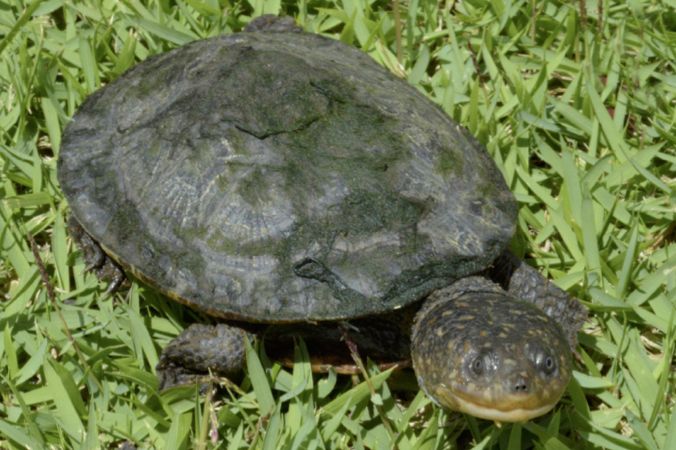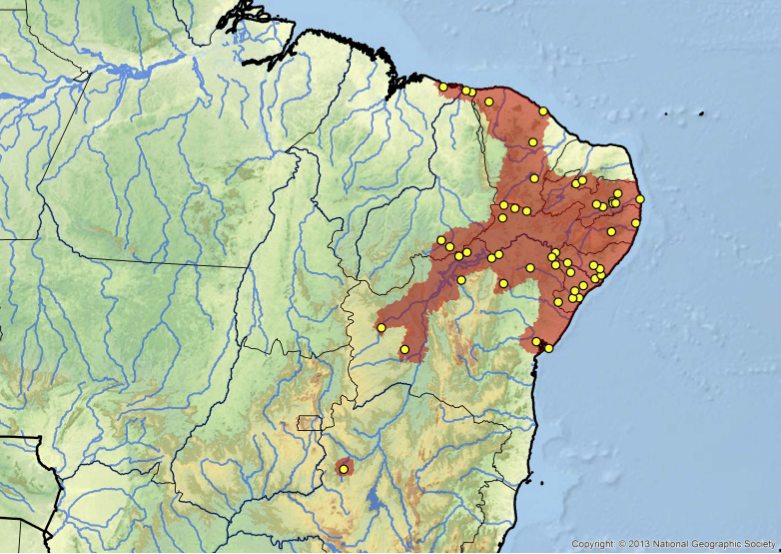Mesoclemmys tuberculata, 097
Mesoclemmys tuberculata (Luederwaldt 1926) –
Tuberculate Toad-headed Turtle
Daniel O. Santana1, Thiago S. Marques2, Gustavo H.C. Vieira1,
Geraldo J.B. Moura3, Renato G. Faria4, and Daniel O. Mesquita1
1Programa de Pós-Graduação em Ciências Biológicas (Zoologia), Universidade Federal da Paraíba,
Cidade Universitária, Campus I, CEP 58059-900, João Pessoa, Paraíba, Brazil
[[email protected]; [email protected]; [email protected]];
2Laboratório de Ecologia Isotópica, Centro de Energia Nuclear na Agricultura, Universidade de São Paulo,
C.P. 96, 13416-000, Piracicaba, São Paulo, Brazil [[email protected]];
3Laboratório de Estudos Herpetológicos e Paleoherpetológicos, Departamento de Biologia,
Universidade Federal Rural de Pernambuco, Rua Morais Rego, s/n, Dois Irmãos,
CEP 52171-900, Recife, Pernambuco, Brazil [[email protected]];
4Programa de Pós-Graduação em Ecologia e Conservação, Universidade Federal de Sergipe,
Cidade Universitária Prof. José Aloísio de Campos,
CEP 49100-000 São Cristóvão, Sergipe, Brazil [[email protected]]
Summary. – The Tuberculate Toad-headed Turtle, Mesoclemmys tuberculata (Family Chelidae), is a medium-sized freshwater turtle (carapace length up to 250–300 mm) endemic to Brazil, ranging from the northeastern semi-arid region to the Atlantic-Northeastern basin. This species is usually associated with Caatinga and Atlantic Forest areas, and strongly associated with the basin of Rio São Francisco. Most aspects of M. tuberculata ecology remain unknown. Sexual dimorphism is prominent, with adult females larger than males. Reproductive parameters such as mean female size, mean clutch size and mass, egg size, volume and mass, incubation time, reproductive season, and nest site description are unknown for wild populations. Diet composition and feeding behavior are poorly known for wild M. tuberculata, but it has been noted that the species is carnivorous and consumes earthworms, fish, molluscs, freshwater shrimp, and insects. The species can often be found associated with anthropogenic environments, such as ponds, which can harbor small populations. Mesoclemmys tuberculata is not currently felt to be threatened, but the lack of population status and life history data for the species are relative limitations to proposing potential conservation measures.
Distribution. – Brazil. Restricted to northeastern Brazil (Alagoas, Bahia, Ceará, Maranhão, Paraíba, Pernambuco, Piauí, Sergipe) with an apparently disjunct population in northern Minas Gerais.
Synonymy. – Rhinemys tuberculata Luederwaldt 1926, Batrachemys tuberculata, Phrynops (Batrachemys) tuberculata, Phrynops tuberculata, Phrynops (Batrachemys) tuberculatus, Phrynops tuberculatus, Phrynops tuberculatus tuberculatus, Mesoclemmys tuberculata.
Subspecies. – None recognized.
Status. – IUCN 2015 Red List: Not Listed (Least Concern, LC, assessed 1996); TFTSG Draft Red List: Data Deficient (DD, assessed 2011); CITES: Not Listed; Brazil: Least Concern.
Citation:
Santana, D.O., Marques, T.S., Vieira, G.H.C., Moura, G.J.B., Faria, R.G., and Mesquita, D.O. 2016. Mesoclemmys tuberculata (Luederwaldt 1926) – Tuberculate Toad-headed Turtle. In: Rhodin, A.G.J., Iverson, J.B., van Dijk, P.P., Saumure, R.A., Buhlmann, K.A., Pritchard, P.C.H., and Mittermeier, R.A. (Eds.). Conservation Biology of Freshwater Turtles and Tortoises: A Compilation Project of the IUCN/SSC Tortoise and Freshwater Turtle Specialist Group. Chelonian Research Monographs 5(9):097.1–8. [doi:10.3854/crm.5.097.tuberculata.v1.2016; //iucn-tftsg.org/cbftt/]
(Adobe Acrobat 6.0 or later required)

Mesoclemmys tuberculata from Areia Branca, Sergipe, Brazil.
Photo by Daniel O. Santana.
Distribution:

Distribution of Mesoclemmys tuberculata in northeastern Brazil. Yellow dots = museum and literature occurrence records of native populations based on Iverson (1992), plus more recent and authors’ data. Red shading = projected historic distribution of M. tuberculata. Distribution based on GIS-defined level 10 HUCs (hydrologic unit compartments) constructed around verified localities and then adding HUCs that connect known point localities in the same watershed or physiographic region, and similar habitats and elevations as verified HUCs (Buhlmann et al. 2009; TTWG 2014), and adjusted based on authors’ subsequent data.








